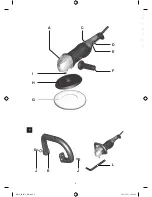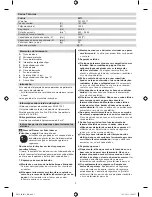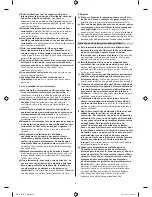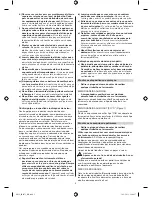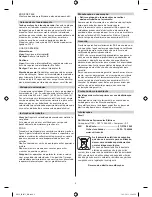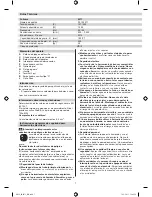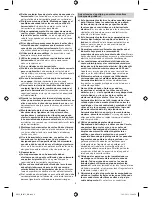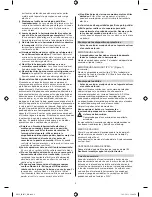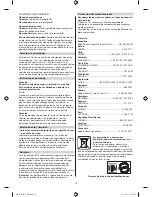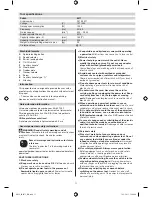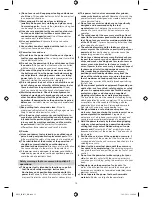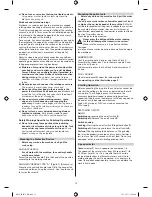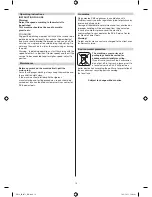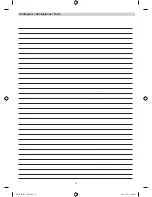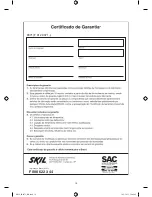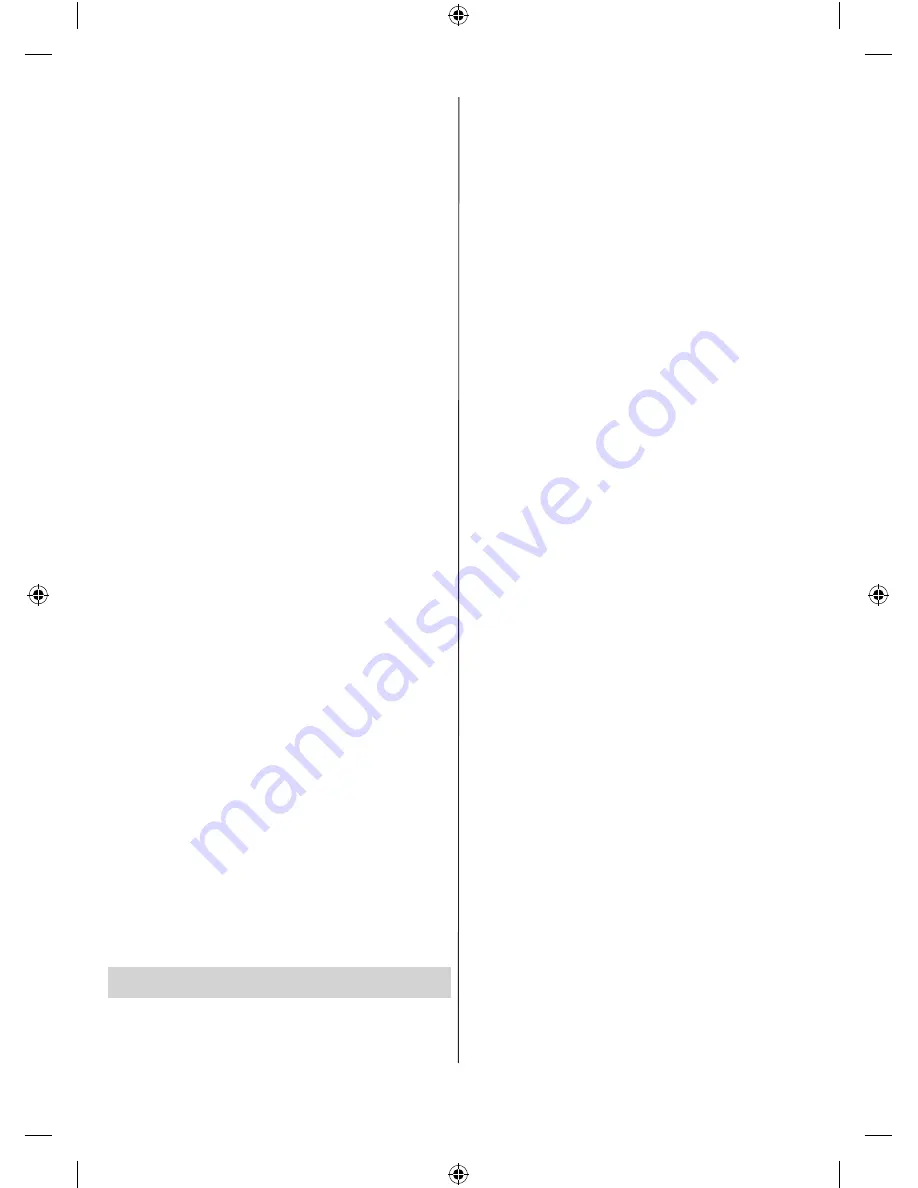
12
e) Do not overreach. Keep proper footing and balance
at all times.
This enables better control of the power tool
in unexpected situations.
f) Dress properly. Do not wear loose clothing or
jewellery. Keep your hair, clothing and gloves away
from moving parts.
Loose clothes, jewellery or long hair
can be caught in moving parts.
g) If devices are provided for the connection of dust ex-
traction and collection facilities, ensure these are
connected and properly used.
Use of these devices
can reduce dust related hazards.
h) Use ear protectors.
Exposure to noise can cause
hearing loss.
i) Use auxiliary handles supplied with the tool.
Loss of
control can cause personal injury.
4) Power tool use and care
a) Do not force the power tool. Use the correct power
tool for your application.
The correct power tool will do
the job better and safer.
b) Do not use the power tool if the switch does not turn
it on and off.
Any power tool that cannot be controlled
with the switch is dangerous and must be repaired.
c) Disconnect the plug from the power source and/or
the battery pack from the power tool before making
any adjustments, changing accessories, or storing
power tools.
Such preventive safety measures reduce
the risk of starting the power tool accidentally.
d) Store idle power tools out of the reach of children and
do not allow persons unfamiliar with the power tool or
these instructions to operate the power tool
.
Power
tools can cause injuries in the hands of untrained users.
e) Maintain power tools. Check for misalignment or
binding of moving parts, breakage of parts and any
other condition that may affect the power tools
operation. If damaged, have the power tool repaired
before use.
Accidents are caused by poorly maintained
power tools.
f) Keep cutting tools sharp and clean.
Properly
maintained cutting tools with sharp cutting edges are less
likely to bind and are easier to control.
g) Use the power tool, accessories and tool bits etc. in
accordance with these instructions and in the manner
intended for the particular type of power tool, taking
into account the working conditions and the work to
be performed.
Use of the power tool for operations
different from those intended could result in injuries.
5) Service
a) Have your power tool serviced by a qualified repair
person using only identical replacement parts.
This
will ensure that the safety of the power tool is maintained.
b) The substitution of the brushes of the power tool
should be accomplished by an authorized and
qualified technical service.
Brushes out of specification
can cause damages to the motor of the power tool.
c)
If the power cord is damaged, the power cord shall be
replaced by manufacturer, service or qualified person to
avoid the risk of electrical shock.
Safety warnings that are common for polish off
operations:
a) This power tool is intended to function as a polish
tool. Read all safety warnings, instructions,
illustrations and specifications provided with this
power tool.
Failure to follow all instructions listed below
may result in electric shock, fire and/or serious injury.
b) This power tool is not recommended for grinder,
sander, wire brush or cut-off.
Operations for which the
power tool was not designed may create a hazard and
cause personal injury.
c) Do not use accessories which are not specifically
designed and recommended by the tool
manufacturer.
Just because the accessory can be
attached to your power tool, it does not assure safe
operation.
d) The rated speed of the accessory must be at least
equal to the maximum speed marked on the power
tool. Do not use accessories maximum rotation low
of the 3.000 min
-1
.
Accessories running faster than their
rated speed can fly apart.
e) The outside diameter and the thickness of your
accessory must be within the capacity rating of your
power tool.
Incorrectly sized accessories cannot be
adequately guarded or controlled.
f) Do not use a damaged accessory. Before each use,
inspect the accessory such as abrasive wheels for
chips and cracks, backing pads for cracks, tears or
excess wear, wire brushes for loose or cracked
wires. If power tool or accessory is dropped, inspect
for damage or install an undamaged accessory.
After inspecting and installing an accessory,
position yourself and bystanders away from the
plane of the rotating accessory and run the power
tool at maximum no-load speed for one minute.
Damaged accessories will normally break apart during
this test time.
g) Wear personal protective equipment. Depending on
application, use face shield, safety goggles or safety
glasses. As appropriate, wear dust mask, hearing
protectors, gloves and shop apron capable of
stopping small abrasive or workpiece fragments.
The eye protection must be capable of stopping flying
debris generated by various operations. The dust mask
or respirator must be capable of filtrating particles
generated by your operation. Prolonged exposure to
high intensity noise may cause hearing loss.
h) Keep bystanders a safe distance away from the
work area. Anyone entering the work area must wear
personal protective equipment.
Fragments of
workpiece or of a broken accessory may fly away and
cause injury beyond immediate area of operation.
i) Hold the power tool only by the insulated gripping
surfaces when performing an operation where the
cutting tool may contact hidden wiring or its own
power cord.
Contact with a “live” wire will also make
exposed metal parts of the power tool “live” and shock
the operator.
j) Position the cord clear of the spinning accessory.
If
you lose control of the power tool, the cord may be cut
or snagged and your hand or arm may be pulled into the
spinning accessory.
k) Never lay the power tool down until the accessory
has come to a complete stop.
The spinning accessory
may grab the surface and pull the power tool out of your
control.
l) Do not run the power tool while carrying it at your
side.
Accidental contact with the spinning accessory
could snag your clothing, pulling the accessory into your
body.
m) Regularly clean the power tool’s air vents.
The
motor’s fan will draw the dust inside the housing and
excessive accumulation of powdered metal may cause
electrical hazards.
n) Do not operate the power tool near flammable
materials.
Sparks could ignite these materials.
SKIL_IB9071_BR.indd 12
30-3-2011 16:04:40


